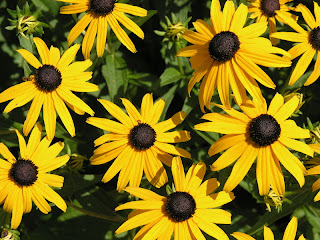Missing my Garden
A blog about gardens, colour, history and any interesting factoids I can find.
Friday, 18 May 2018
How Luther Burbank Made the Shasta Daisy (Reblog)
http://www.lutherburbank.org/about-us/shasta-daisy
Thursday, 9 August 2012
How Cliches Get That Way
Cary Grant said that cliches become cliches because they're true. Rudbeckia 'Goldsturm' and aster 'Mönch' or else 'Little Carlow' have become gardening cliches, or if you prefer a classic plant combination, because they work so well together.
The two work so well together because the aster not only looks good with the rudbeckia, its blue cooling the other's brassy yellow, but because it can stand up to the somewhat bullying demeanour of black-eyed susans, who tend to run at the roots. Although, having said that, 'Goldsturm' is pretty well behaved. It runs a bit, but not uncontrollably.
 |
| Rudbeckia fulgia var. sulliviani 'Goldsturm', photo by Lukas Riebling |
 |
| Aster x frikartii ‘Mönch’' |
Tuesday, 31 July 2012
Eurybia divaricata (Aster divaricatus)
The white woodland aster, or eurybia divaricata, is a quiet beauty. It has sprays of white, starry flowers from June to October in England, from late summer through the fall in North America.
The leaves are heart-shaped, with a slight twist at the pointed end, as if someone had tweaked them. They also have a surprisingly spring-like fresh green to them all season long. The purple-black stems are twisty, with the flower sprays pointing this way and that. These stems are what give the plant part of its name, since divaricata means "straggly, sprawling, or spreading". The leaves and stems have also provided common names for the plant: Heartleaf Aster and Serpentine Aster.
 |
| Eurybia divaricata, photo by Tom Potterfield, Creative Commons |
What Colour is Alma?
 |
| Picture by Joan Hall, Creative Commons |
Sunday, 29 July 2012
Spacing - Not an Exact Science
Ever had the experience of having to fill in space between plants? Maybe something died, or you hated it and hauled it out. (If it died, maybe it hated you. I should really write a post on plant suicide sometime.) Or perhaps you're starting from scratch and grappling with those wonderful books where they tell you how big and how wide your plants will get. They usually go on to tell you to map out your new garden on graph paper, using the measurements to figure out how many of each you need.
I don't want to knock the graph-paper method, but the problem is that once you've got the plants in the ground, they tend to have their own ideas about how big (or not) they want to be. There's only so much you can do about that.
I don't want to knock the graph-paper method, but the problem is that once you've got the plants in the ground, they tend to have their own ideas about how big (or not) they want to be. There's only so much you can do about that.
Thursday, 26 July 2012
Learning from Your Mistakes
As you've probalby noticed if you've visited this blog before, it's been redesigned. I ran it through a readability test, and failed. Too dark, too many colours, too confusing. (I would love to give you the link for the test, but I've lost it.)
I read a few pages on blog design, and learned a great deal. No more than three colours, Keep it light, keep it simple. So the new version has a lot more white in it, and I've changed the font. I feel embarrased about how it looked before now - but what can I say, I love colour.
Hope you like it, and feel free to let me know what you think.
I read a few pages on blog design, and learned a great deal. No more than three colours, Keep it light, keep it simple. So the new version has a lot more white in it, and I've changed the font. I feel embarrased about how it looked before now - but what can I say, I love colour.
Hope you like it, and feel free to let me know what you think.
Wednesday, 25 July 2012
More Impurity
On the subject of "impure blue", I saw the following discussion on GardenWeb, and enjoyed it immensely, although one sentence from Kirk Johnson really stood out:
Blue is one color and purple is blue with red thrown in. Why do all the gardening publications insist on calling purple "blue" when they don't call orange "red"? Why pretend?
Subscribe to:
Comments (Atom)


